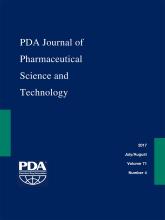Abstract
Among the factors that affect the glass surface chemical durability, pH and complexing agents present in aqueous solution have the main role. Glass surface attack can be also related to the delamination issue causing glass particles' appearance in the pharmaceutical preparation. A few methods to check for glass containers delamination propensity and some control guidelines have been proposed. The present study emphasizes the possible synergy between a few complexing agents with pH on borosilicate glass chemical durability.
Hydrolytic attack was performed in small-volume 23 mL type I glass containers autoclaved according to the European Pharmacopoeia or United States Pharmacopeia for 1 h at 121 °C, in order to enhance the chemical attack due to time, temperature, and the unfavorable surface/volume ratio. Solutions of 0.048 M or 0.024 M (M/L) of the acids citric, glutaric, acetic, EDTA (ethylenediaminetetraacetic acid), together with sodium phosphate with water for comparison, were used for the trials. The pH was adjusted ±0.05 units at fixed values 5.5, 6.6, 7, 7.4, 8, and 9 by LiOH diluted solution.
Because silicon is the main glass network former, silicon release into the attack solutions was chosen as the main index of the glass surface attack and analysed by inductively coupled plasma atomic emission spectrophotometry. The work was completed by the analysis of the silicon release in the worst attack conditions of molded glass, soda lime type II glass, and tubing borosilicate glass vials to compare different glass compositions and forming technologies. Surface analysis by scanning electron microscopy was finally performed to check for the surface status after the worst chemical attack condition by citric acid.
LAY ABSTRACT: Glass, like every packaging material, can have some usage limits, mainly in basic pH solutions. The issue of glass surface degradation particles that appear in vials (delamination) has forced a number of drug product recalls in recent years. To prevent such situations, pharmaceutical and biopharmaceutical manufacturers need to understand the reasons for accelerate surface glass corrosion mainly in the case of injectables.
Some drugs can contain active components with known ability to corrode glass silica networks. Sometimes these ingredients are dissolved in an alkaline medium that dramatically increases the glass corrosion and potentially causes the issue. As this action is strongly affected by time and temperature, flaking may become visible only after a long storage time. The purpose of this investigation is to verify the borosilicate glass chemical durability during controlled conditions of time and temperature when in contact with testing solutions containing different complexing agents by varying the pH. Si concentration in the extract solution is taken as an index of glass dissolution during constant autoclaving conditions for 1 h at 121 °C, which simulates approximately five years of contact at room temperature.
Acetate, citrate, ethylenediaminetetraacetic acid (EDTA), phosphate, and glutarate 0.048 M or 0.024 M solutions were used at increasing pH from 5.5 to 9.0. The chemical durability of two borosilicate tubing glass vials of different glass compositions were compared with the molded one in the worst attack conditions by citric acid. Even if no delamination issue has been experienced by this study in type I molded and tubing containers, the conclusions developed can provide pharmaceutical manufacturers with useful information to prevent glass delamination risk in their processes.
- Glass chemical durability
- Hydrolytic resistance
- Complexing agents
- Borosilicate type I glass
- Soda lime type II glass
- Silicon release
- pH
- © PDA, Inc. 2017
PDA members receive access to all articles published in the current year and previous volume year. Institutional subscribers received access to all content. Log in below to receive access to this article if you are either of these.
If you are neither or you are a PDA member trying to access an article outside of your membership license, then you must purchase access to this article (below). If you do not have a username or password for JPST, you will be required to create an account prior to purchasing.
Full issue PDFs are for PDA members only.
Note to pda.org users
The PDA and PDA bookstore websites (www.pda.org and www.pda.org/bookstore) are separate websites from the PDA JPST website. When you first join PDA, your initial UserID and Password are sent to HighWirePress to create your PDA JPST account. Subsequent UserrID and Password changes required at the PDA websites will not pass on to PDA JPST and vice versa. If you forget your PDA JPST UserID and/or Password, you can request help to retrieve UserID and reset Password below.






